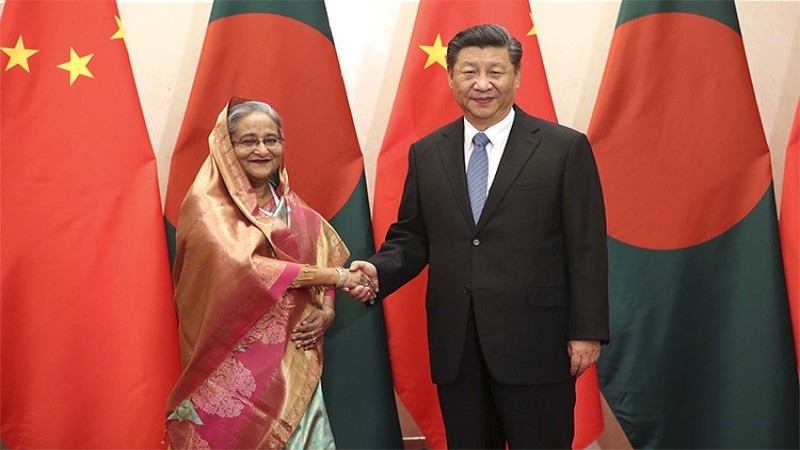Conventional wisdom says great power rivalry makes smaller neighbors vulnerable. As recently echoed by Singaporean Prime Minister Lee Hsien Loong, “When elephants fight, the grass suffers, but when they make love, the grass suffers also.” However, this conventional wisdom seems flawed in the case of the China-India rivalry for regional influence in Bangladesh. Instead of losing, the small South Asian country is reaping benefits.
In addition to Bangladesh’s pivotal geographical location on the contested Indian Ocean, it is one of the world’s fastest-growing economies and, with 160 million people, the eighth most populous country in the world. The size of the population, which signifies the size of the market, helps overshadow the small territorial size of this country. Bangladesh recently became eligible to graduate to developing country status by 2024. Still, development — both physical (large-scale infrastructure and military capabilities) and social (human resources and services) — is likely to persist as a dominant national priority for Bangladesh in the coming decades. Therefore, the country is keen to leverage the China-India rivalry in order to fulfill its growing demands for foreign direct investment (FDI) and beyond.
In Bangladeshi geopolitics, India has always been at the center while the United States has had leverage. Other regional powers such as China used to be on the periphery. Historically Bangladesh has more cultural and societal links with India. India, Pakistan, and Bangladesh are collectively known as a subcontinent. However, India’s hegemonic posture and coercive tactics created deep resentment among ordinary Bangladeshis, especially when contrasted with China’s model of noninterference in domestic affairs coupled with lavish spending.
China’s economic engagement with South Asian countries – with the exception of long-time partner Pakistan — only began to ramp up in the last two decades. In this short period of time, China has emerged as a top trade partner for Bangladesh. In 2015, China became Bangladesh’s top trading partner, knocking India out of the position it had held for 40 years. Imports from China represent 34 percent of Bangladesh’s total.
As a member of China’s Belt and Road Initiative, Bangladesh has seen an influx of Chinese investment in recent times. Beijing’s support of Bangladesh was evident in the 27 agreements for investments and loans signed by the two countries – worth some $24 billion – when President Xi Jinping visited in 2016. Along with an earlier $13.6 billion investment in joint ventures, those deals brought Chinese investment in Bangladesh to a total of $38 billion, the largest sum ever pledged to Bangladesh by a single country.
This large amount of Chinese investment in India’s most trusted, friendly neighbor made New Delhi feel it was falling behind. Therefore, in response, India announced $5 billion in loans for Bangladesh in 2017, which is the largest amount ever invested by India in Bangladesh.
As a rapidly developing economy Bangladesh is in dire need of investment, while China and India both see investment in Bangladesh as a way to extend their influence. Bangladesh is seizing the opportunity and using both China and India to fill its FDI deficit.
There is also a strong security dimension to these relationships. Bangladesh is surrounded by India on three sides, and their shared 4096-kilometer land border is the fifth-longest in the world. The Bay of Bengal, located to the south of Bangladesh, is a frontier that is watched over by the comparatively powerful Indian Navy. Bangladesh also has a maritime dispute with India in the strategic Bay of Bengal.
China has become Bangladesh’s top source for arms imports; and Dhaka likewise is China’s second-largest arms export destination in the world, behind Pakistan. Bangladesh accounts for 20 percent of all Chinese arms sales. Beijing has provided Dhaka with five maritime patrol vessels, two submarines, 16 fighter jets, and 44 tanks, as well as anti-ship and surface-to-air missiles. Most recently, in 2017 the Bangladesh Navy took delivery of two Chinese submarines at a minimum price. This agreement made India uncomfortable; thus New Delhi expressed interest in offering submarine training for the Bangladesh Navy. Again, while China and India seek to expand their influence in the Bay of Bengal, Bangladesh is using both to make necessary improvements to its military.
If the China-India strategic rivalry intensifies, both countries will double down on their approach to bringing strategically located Bangladesh into their own orbit. China, along with increasing investment, may also open its economy to billions of dollars in imports from Bangladesh, which will help the country to diversify its exports to a new destination beyond North America and Europe. On the Indian side, New Delhi may ramp up the diplomatic and cultural ties with Bangladesh. India and China will do their best to edge each other out in their competition for dominance in the Bay of Bengal and will try to squeeze an economically weak Bangladesh.
However, Bangladesh should be aware that both India and China will be primarily self-serving in their investments. To avoid being a passive victim of this geopolitical competition in the Bay of Bengal, Bangladesh should use its strategic piston tactfully. One way of getting the most out of India-China competition is to remain elusive, without showing a preference between the two giants. Maintaining good working relations with both India and China is crucial for an economically and infrastructurally weak Bangladesh.
































